Search Result
Results for "
Melanin Inhibitors
" in MedChemExpress (MCE) Product Catalog:
1
Biochemical Assay Reagents
7
Isotope-Labeled Compounds
| Cat. No. |
Product Name |
Target |
Research Areas |
Chemical Structure |
-
- HY-W015967
-
-
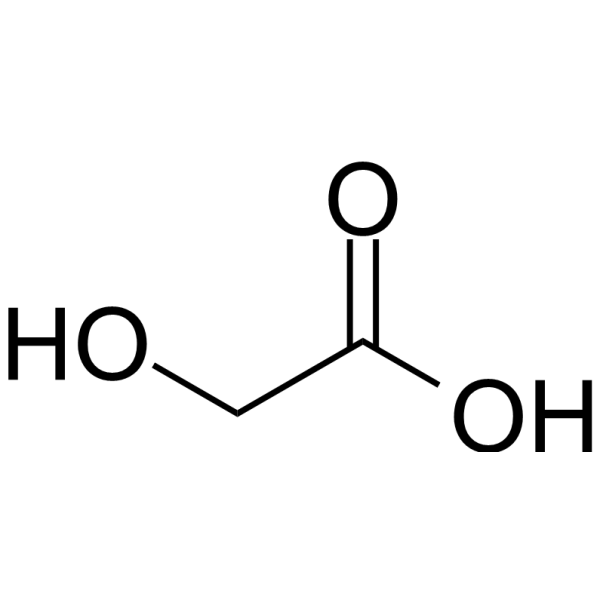
-
- HY-161241
-
|
|
Tyrosinase
|
Cancer
|
|
Tyrosinase-IN-23 (Compd 11m) is a tyrosinase inhibitor with an IC50 of 55.39±4.93 µM. Tyrosinase-IN-23 can be used for research of melanin biosynthesis .
|
-

-
- HY-N9521
-
|
|
Others
|
Cancer
|
|
3-O-β-D-Glucopyranosyl(1→2)-[a-Lrhamnopyranosyl(1→3)]-β-D-glucopyranosyl 28-O-β-D-glucuronopyranoside, a saponin, is isolated from Polaskia chichipe Backbg. 3-O-β-D-Glucopyranosyl(1→2)-[a-Lrhamnopyranosyl(1→3)]-β-D-glucopyranosyl 28-O-β-D-glucuronopyranoside shows ability to inhibit melanin biosynthesis by B16 melanoma cell with inhibitory activity 84.2% at 100μM[1].
|
-
![3-O-β-D-Glucopyranosyl(1→2)-[a-Lrhamnopyranosyl(1→3)]-β-D-glucopyranosyl 28-O-β-D-glucuronopyranoside](//file.medchemexpress.com/product_pic/hy-n9521.gif)
-
- HY-N2902
-
|
|
Others
|
Cancer
|
|
Artocarpin is an isoprenoid-substituted flavonoid, that can be isolated from the wood of Artocarpus heterophyllus. Artocarpin inhibits melanin biosynthesis in B16 melanoma cells without inhibiting tyrosinase. The presence of the isoprenoid-substituted moiety enhanced the inhibitory activity on melanin production in B16 melanoma cells .
|
-
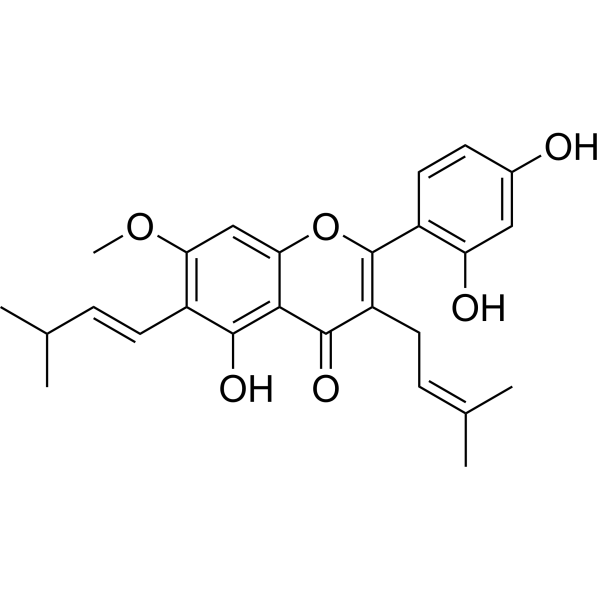
-
- HY-W725641
-
|
|
Bacterial
|
Infection
|
|
Tricyclazole-d3 is the deuterium labeled Tricyclazole. Tricyclazole is a pentaketide-derived melanin biosynthesis inhibitor.
|
-
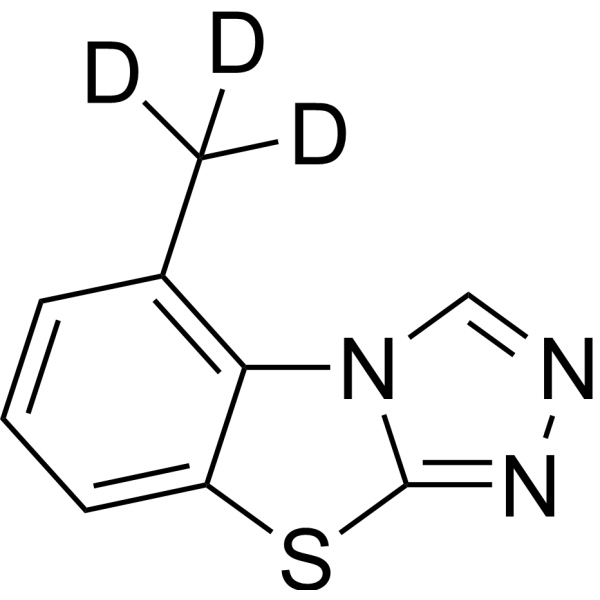
-
- HY-163326
-
|
|
Tyrosinase
|
Cancer
|
|
Tyrosinase-IN-25 (compound 1l) is an inhibitor of tyrosinase and melanin biosynthesis in human melanoma cells .
|
-

-
- HY-B0848
-
|
|
Bacterial
|
Infection
|
|
Tricyclazole is a pentaketide-derived melanin biosynthesis inhibitor and a unique fungicide for control of Pyricularia oryzae on rice .
|
-
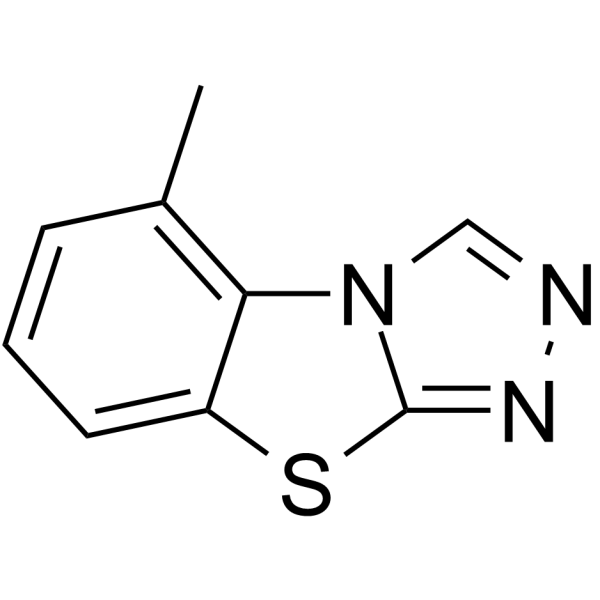
-
- HY-N12491
-
|
|
Others
|
Cancer
|
|
12-Methylcarnosol is a phenolic diterpene-carnosone, but lacks the ability of other phenolic diterpenes-carnosone to inhibit melanin synthesis .
|
-
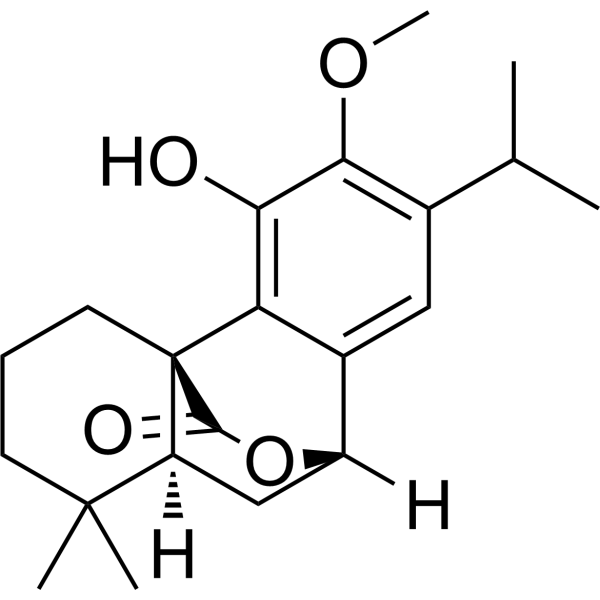
-
- HY-B1461
-
|
|
Tyrosinase
|
Others
|
|
Deoxyarbutin can effectively inhibit tyrosinase activity and melanin synthesis, thereby achieving significant and lasting whitening effects, and has a strong antioxidant effect.
|
-

-
- HY-W015967S
-
-
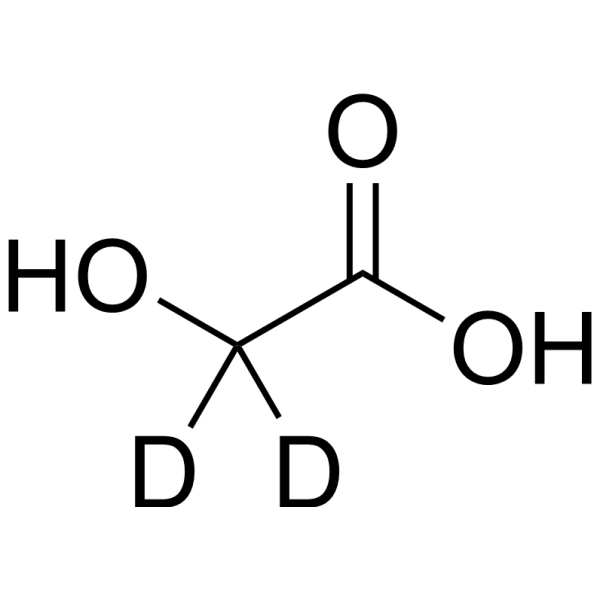
-
- HY-N7587
-
|
|
Melanocortin Receptor
|
Metabolic Disease
|
|
Chlorophorin is a inhibitor of Melanocortin Receptor. Chlorophorin reduces tyrosinase activity and inhibits a-melanocyte-stimulating hormone-induced melanin production in B16F10 melanoma cells .
|
-

-
- HY-W015967R
-
|
Hydroxyethanoic acid (Standard)
|
Endogenous Metabolite
Tyrosinase
|
Metabolic Disease
|
|
Glycolic acid (Standard) is the analytical standard of Glycolic acid. This product is intended for research and analytical applications. Glycolic acid is an inhibitor of tyrosinase, suppressing melanin formation and lead to a lightening of skin colour.
|
-
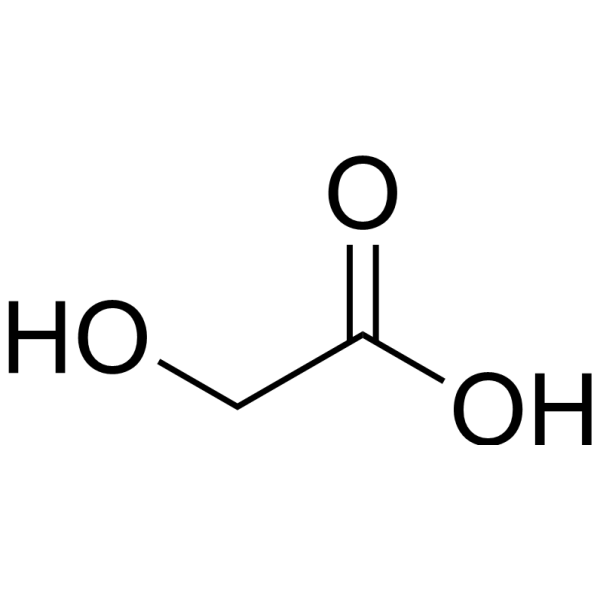
-
- HY-N12431
-
|
|
Others
|
Cancer
|
|
Machilin A is a lignan isolated from the methanolic extract of Phoebe bark. Machilin A inhibits melanin biosynthesis in B-16 mouse melanoma cells with an IC50 of 39.9 μM.
|
-
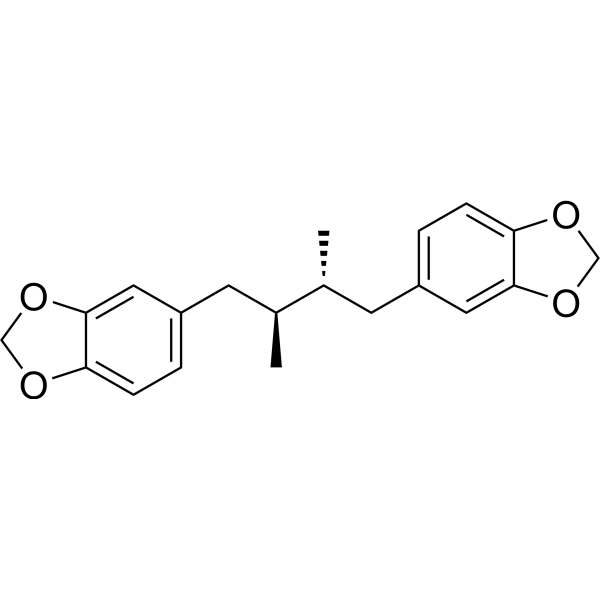
-
- HY-N4191
-
|
|
Cholinesterase (ChE)
|
Neurological Disease
|
|
Isorosmanol is an abietane-type diterpene isolated from Rosmarinus officinalis L. aerial parts, with antioxidant, neuroprotective and neurotrophic effects. Isorosmanol inhibits AChE activity and melanin synthesis .
|
-
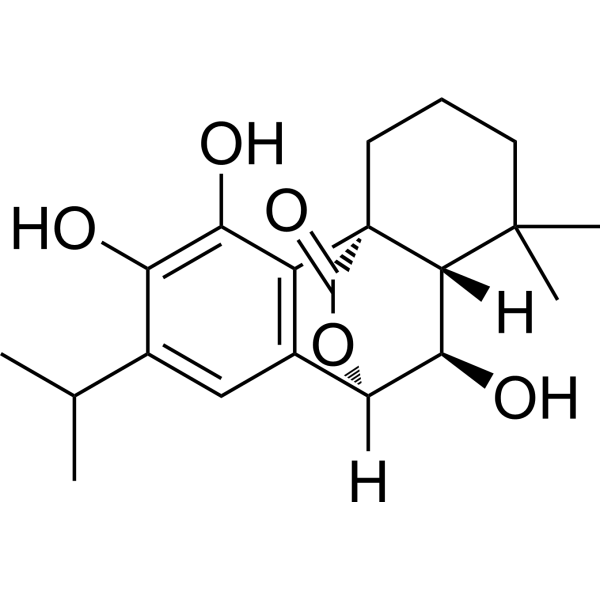
-
- HY-Y0444
-
|
|
Tyrosinase
|
Metabolic Disease
|
|
D-Tyrosine is the D-isomer of tyrosine. D-Tyrosine negatively regulates melanin synthesis by inhibiting tyrosinase activity. D-Tyrosine inhibits biofilm formation and trigger the self-dispersal of biofilms without suppressing bacterial growth .
|
-
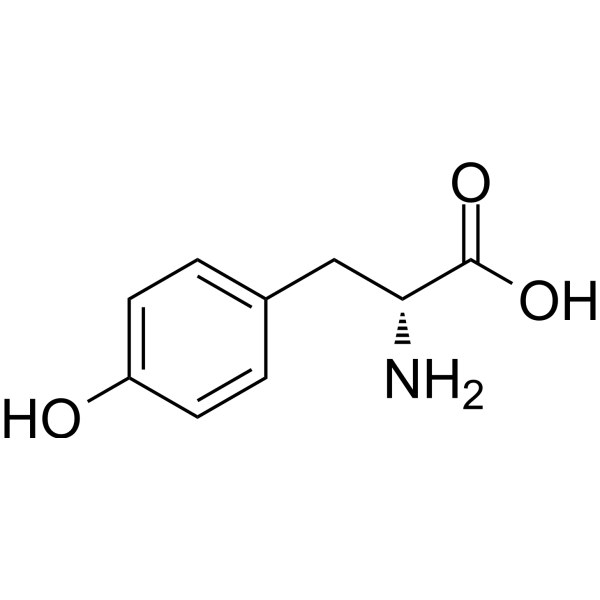
-
- HY-W778203
-
|
Hydroxyethanoic acid-13C2
|
Isotope-Labeled Compounds
|
Others
|
|
Glycolic acid- 13C2 is the 13C-labeled Glycolic acid (HY-W015967). Glycolic acid- 13C2 is an inhibitor of tyrosinase, suppressing melanin formation and lead to a lightening of skin colour.
|
-
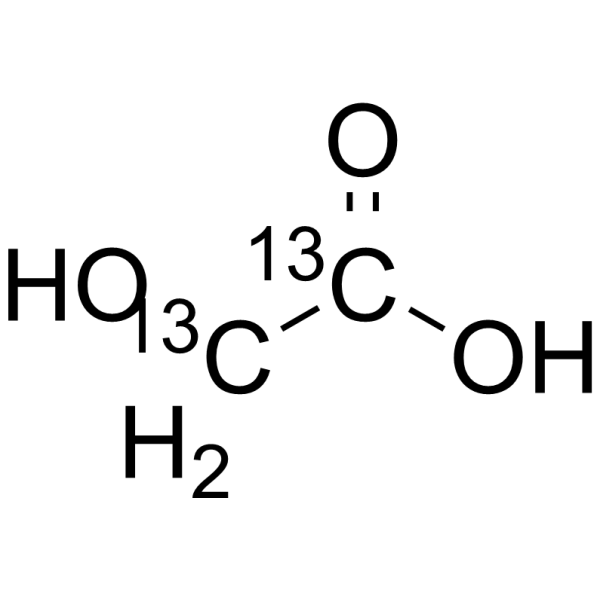
-
- HY-100321
-
-
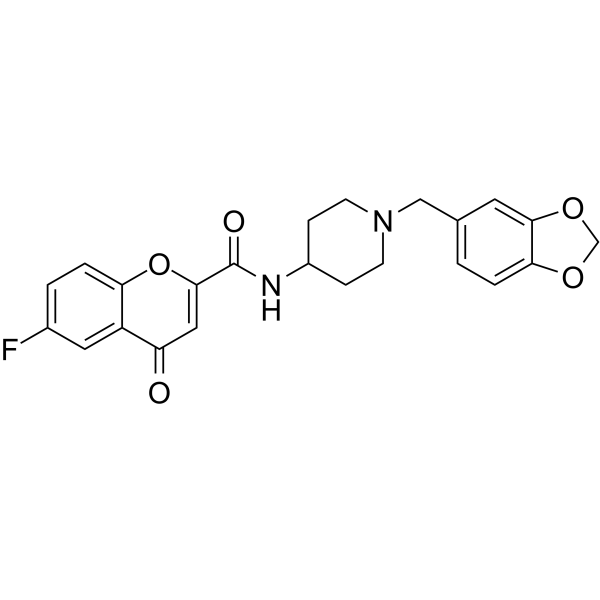
-
- HY-111898
-
|
|
Others
|
Cancer
|
|
Epirosmanol is a nature diterpene lactone from S. officinalis. Epirosmanol shows anti-cancer activity and inhibits melanin biosynthesis against melanoma cells. Epirosmanol also exhibits DPPH radical scavenging activity .
|
-
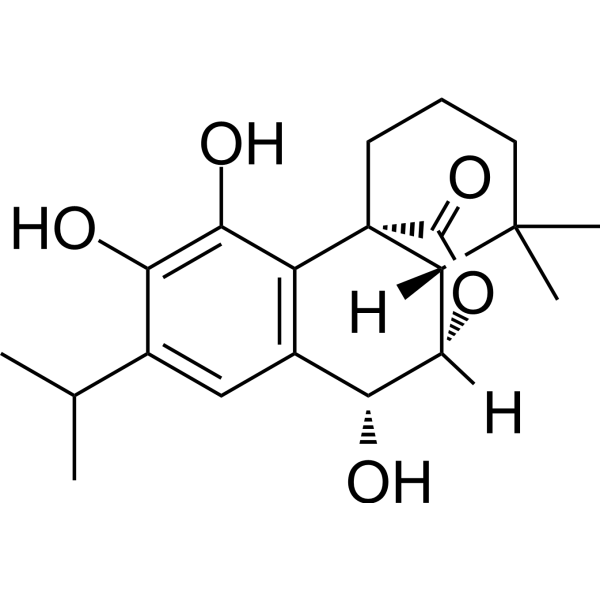
-
- HY-N10437
-
|
6-O-Acetylnimbandiol
|
Tyrosinase
|
Cancer
|
|
6-Acetylnimbandiol (6-O-Acetylnimbandiol) is a non-cytotoxic tyrosinase inhibitor (IC50=69.85 μM) that effectively inhibits melanin production and MITF expression. 6-Acetylnimbandiol can be used in melanoma research .
|
-
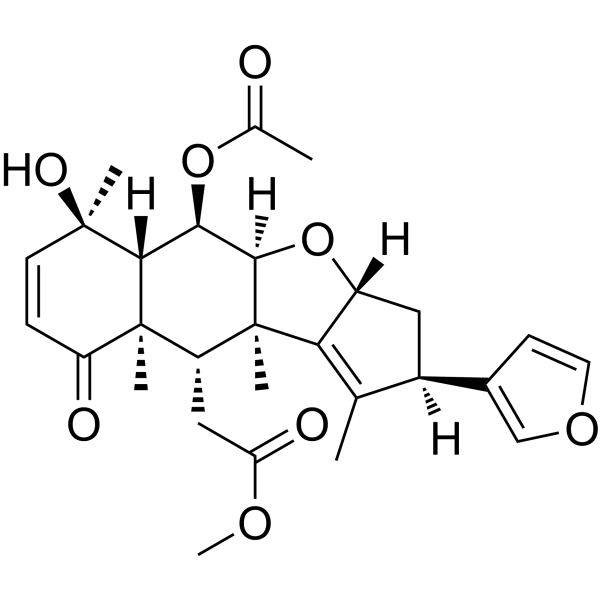
-
- HY-100331
-
-
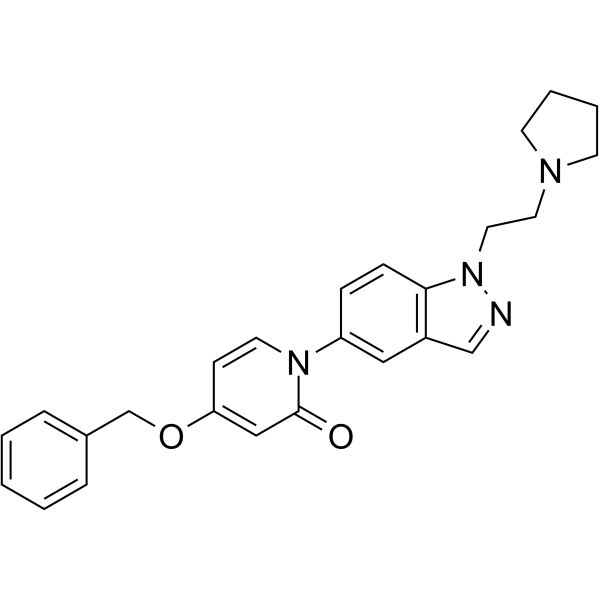
-
- HY-N3200
-
|
|
Tyrosinase
|
Cancer
|
|
Neorauflavane is a potent tyrosinase inhibitor derived from Campylotropis hirtella, with an IC50 value of 30 nM for tyrosinase monophenolase activity and an IC50 value of 500 nM for diphenolase activity. Neorauflavane can effectively reduce the melanin content of B16 melanoma cells .
|
-

-
- HY-112367
-
|
|
Others
|
Cancer
|
|
SB 202474, a negative analog of SB203580. SB 202474, which has no ability to inhibit p38 MAPK activity and is widely used as a negative control compound in p38 MAPK studies, also suppressed melanin synthesis induction .
|
-
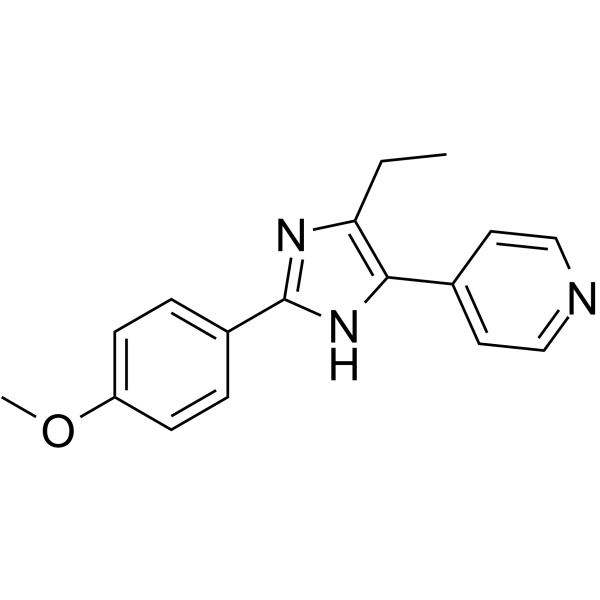
-
- HY-149698
-
|
|
Tyrosinase
|
Cancer
|
|
Tyrosinase-IN-17 (Compound 5b) is a lipophilic, skin-permeable, and non-cytotoxic Tyrosinase inhibitor (pIC50=4.99). Tyrosinase-IN-17 can be used for research on melanin-related diseases, such as melanoma, melanogenesis, etc .
|
-
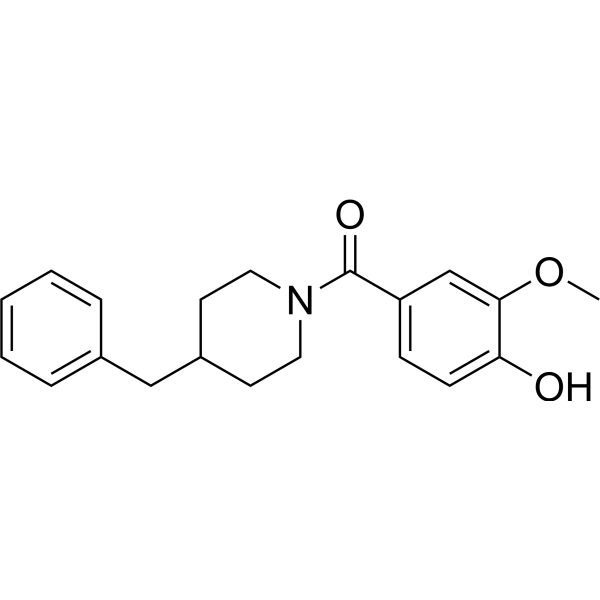
-
- HY-143450
-
|
|
Tyrosinase
|
Others
|
|
Tyrosinase-IN-3 (compound 54) is a potent inhibitor of tyrosinase. Tyrosinase is a copper-containing metalloenzyme that is responsible for the rate-limiting catalytic step in the melanin biosynthesis and enzymatic browning. Tyrosinase-IN-3 has the potential for the research of skin whitening agents and food preservatives .
|
-
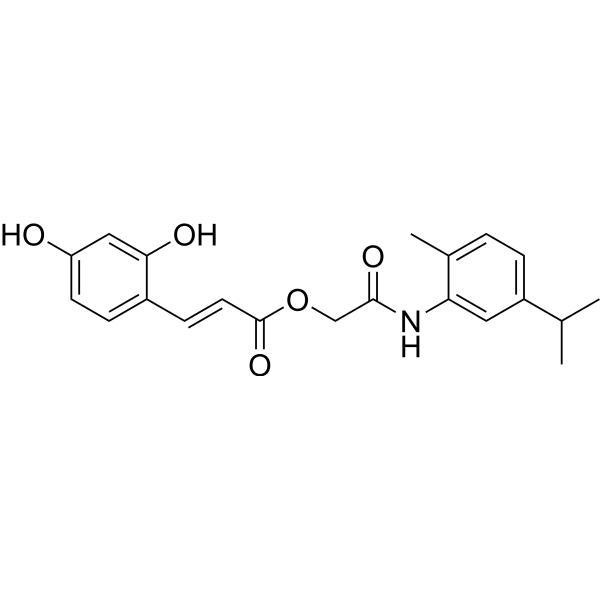
-
- HY-143451
-
|
|
Tyrosinase
|
Others
|
|
Tyrosinase-IN-4 (compound 34) is a potent inhibitor of tyrosinase. Tyrosinase is a copper-containing metalloenzyme that is responsible for the rate-limiting catalytic step in the melanin biosynthesis and enzymatic browning. Tyrosinase-IN-4 has the potential for the research of skin whitening agents and food preservatives .
|
-
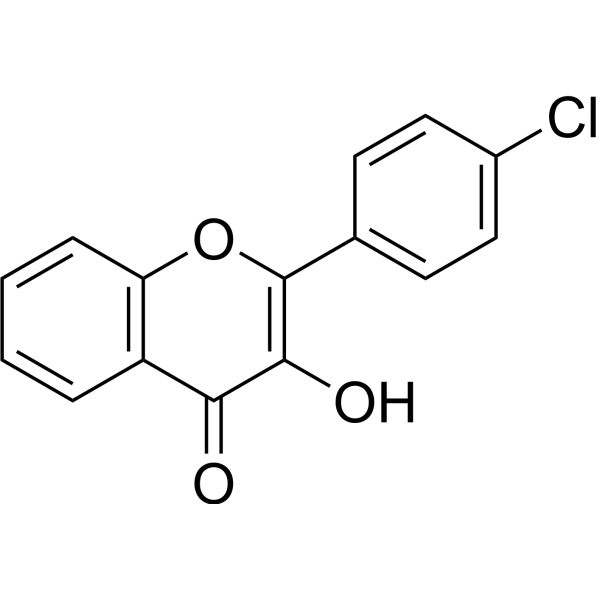
-
- HY-143448
-
|
|
Tyrosinase
|
Others
|
|
Tyrosinase-IN-1 (compound 90) is a potent inhibitor of tyrosinase. Tyrosinase is a copper-containing metalloenzyme that is responsible for the rate-limiting catalytic step in the melanin biosynthesis and enzymatic browning. Tyrosinase-IN-1 has the potential for the research of skin whitening agents and food preservatives .
|
-
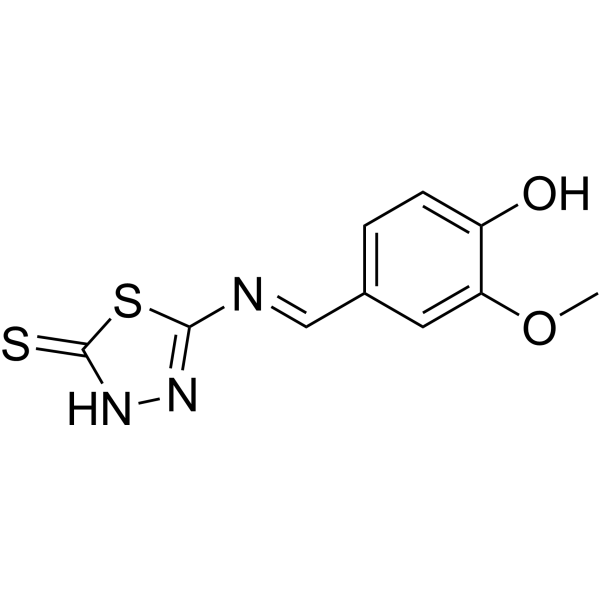
-
- HY-143449
-
|
|
Tyrosinase
|
Others
|
|
Tyrosinase-IN-2 (compound 67) is a potent inhibitor of tyrosinase. Tyrosinase is a copper-containing metalloenzyme that is responsible for the rate-limiting catalytic step in the melanin biosynthesis and enzymatic browning. Tyrosinase-IN-2 has the potential for the research of skin whitening agents and food preservatives .
|
-
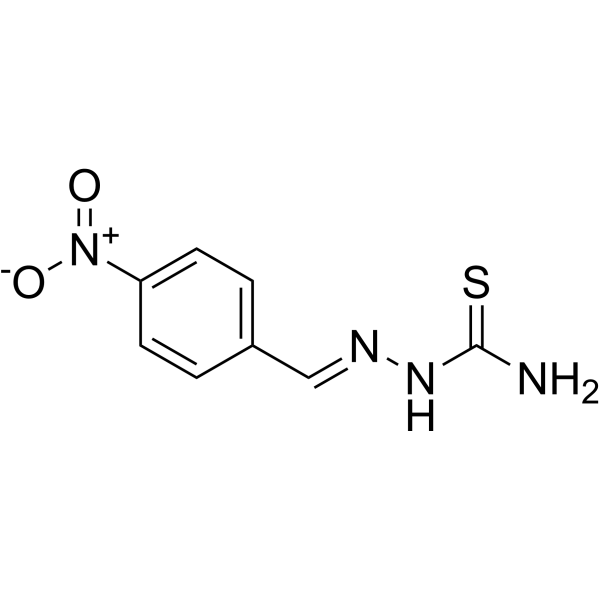
-
- HY-Y0444S
-
|
|
Isotope-Labeled Compounds
Tyrosinase
|
|
|
D-Tyrosine-d2 is the deuterium labeled D-Tyrosine. D-Tyrosine is the D-isomer of tyrosine. D-Tyrosine negatively regulates melanin synthesis by inhibiting tyrosinase activity. D-Tyrosine inhibits biofilm formation and trigger the self-dispersal of biofilms without suppressing bacterial growth[1][2].
|
-

-
- HY-Y0444S1
-
|
|
Tyrosinase
|
|
|
D-Tyrosine-d4 is the deuterium labeled D-Tyrosine. D-Tyrosine is the D-isomer of tyrosine. D-Tyrosine negatively regulates melanin synthesis by inhibiting tyrosinase activity. D-Tyrosine inhibits biofilm formation and trigger the self-dispersal of biofilms without suppressing bacterial growth[1][2].
|
-

-
- HY-Y0444S2
-
|
|
Isotope-Labeled Compounds
Tyrosinase
|
|
|
D-Tyrosine-d7 is the deuterium labeled D-Tyrosine. D-Tyrosine is the D-isomer of tyrosine. D-Tyrosine negatively regulates melanin synthesis by inhibiting tyrosinase activity. D-Tyrosine inhibits biofilm formation and trigger the self-dispersal of biofilms without suppressing bacterial growth[1][2].
|
-
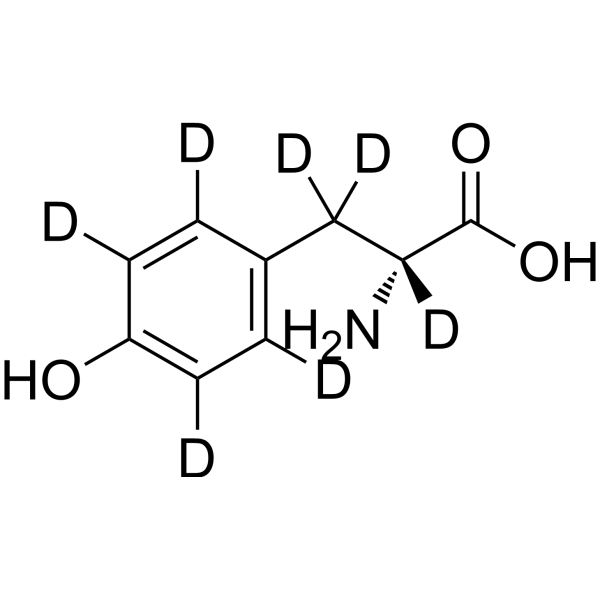
-
- HY-N2204
-
|
|
Tyrosinase
|
Inflammation/Immunology
|
|
Swertiajaponin is a tyrosinase inhibitor, forms multiple hydrogen bonds and hydrophobic interactions with the binding pocket of tyrosinase, with an IC50 of 43.47 μM. Swertiajaponin also inhibits oxidative stress-mediated MAPK/MITF signaling, leading to decrease in tyrosinase protein level. Swertiajaponin suppresses melanin accumulation and exhibits strong anti-oxidative activity .
|
-

-
- HY-133680
-
|
|
Tyrosinase
|
Metabolic Disease
|
|
β-Tocopherol is an analogue of vitamin E, exhibits antioxidant properties. β-Tocopherol can inhibit tyrosinase activity and melanin synthesis. β-Tocopherol also can prevent the inhibition of cell growth and of PKC activity caused by d-alpha-tocopherol .
|
-

-
- HY-125809
-
|
|
Biochemical Assay Reagents
|
Others
|
|
4-(1-Phenylethyl)resorcinol is a skin lightening agent used in cosmetics. It works by inhibiting the production of melanin, the pigment that gives skin its color. This helps reduce the appearance of dark spots, hyperpigmentation and uneven skin tone. 4-(1-Phenylethyl)resorcinol is considered safe for cosmetic use and is approved for use in several countries.
|
-

-
- HY-113068
-
|
|
Tyrosinase
|
Metabolic Disease
|
|
(rel)-β-Tocopherol is a relative configuration of β-Tocopherol.(±)-β-Tocopherol is a lipid-soluble form of vitamin E with antioxidant activity. β-Tocopherol can inhibit tyrosinase activity and melanin synthesis. β-Tocopherol also can prevent the inhibition of cell growth and of PKC activity caused by d-alpha-tocopherol .
|
-
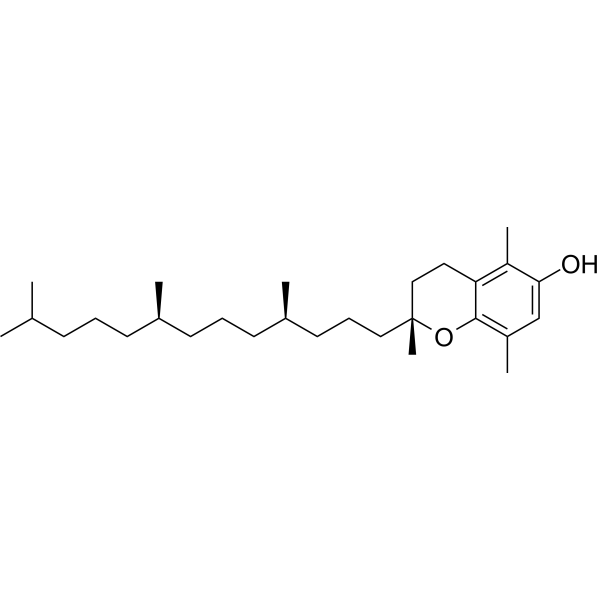
-
- HY-107663
-
|
Pro-Leu-Gly-NH2; Melanostatin
|
Dopamine Receptor
|
Neurological Disease
|
|
MIF-1 (Melanostatin), an endogenous brain peptide, is a potent dopamine receptor allosteric modulator. MIF-1 inhibits melanin formation. MIF-1 blocks the effects of opioid receptor activation to modulate the analgesic effects. MIF-1 accesses from the blood to the CNS by directly crossing the blood-brain barrier (BBB) .
|
-
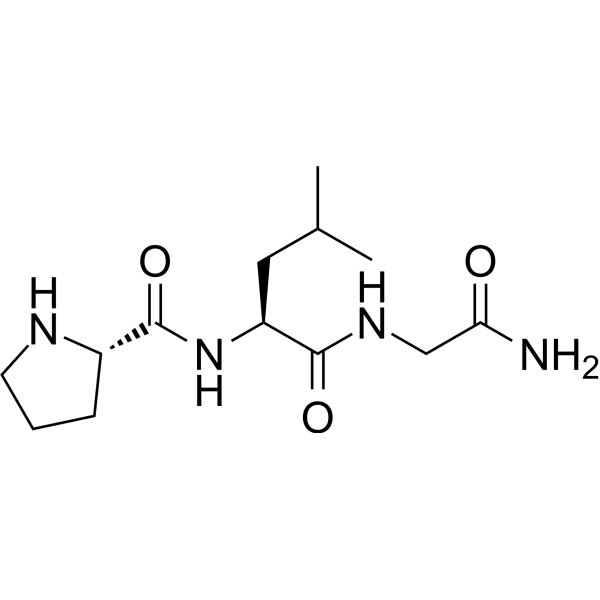
-
- HY-P0096
-
|
|
Tyrosinase
Sirtuin
|
Inflammation/Immunology
Endocrinology
|
|
Decapeptide-12, a small oligopeptide, is a tyrosinase inhibitor that interacts with C-terminal residue of tyrosinase (Kd: 61.1 μM). Decapeptide-12 is a competitive inhibitor of mushroom tyrosinase (IC50: 40 µM). Decapeptide-12 also increases transcription of SIRT. Decapeptide-12 reduces melanin content in melanocytes. Decapeptide-12 is used for the research of melanogenesis, senescence, inflammation .
|
-

-
- HY-N3716
-
|
|
Aldose Reductase
COX
|
Metabolic Disease
Inflammation/Immunology
|
|
Dehydroglyasperin D inhibits rat and human Aldose Reductase (AR) (IC50: 62.4 μM and 176.2 μM respectively). Dehydroglyasperin D has anti-obesity, antioxidant effects. Dehydroglyasperin D shows anti-inflammatory activity by inhibiting COX-2 expression and the MLK3 signaling pathway. Dehydroglyasperin D also inhibits melanin synthesis. Dehydroglyasperin D is a prenylated flavonoid that can be isolated from Glycyrrhiza uralensi .
|
-

-
- HY-N3810
-
|
|
Tyrosinase
|
Others
|
|
ent-11α-Hydroxy-15-oxokaur-16-en-19-oic acid is an anti-melanin synthesis tyrosinase inhibitor, which can be isolated from Pteris fern. ent-11α-Hydroxy-15-oxokaur-16-en-19-oic acid regulates the melanogenesis transcription factor microphthalmia-associated transcription factor (MITF). The 11α-OH, 15-oxo and 16-en moieties of ent-11α-Hydroxy-15-oxokaur-16-en-19-oic acid are key fragments that inhibit melanin synthesis. The 19-COOH moiety has been implicated in the inhibition of cytotoxicity associated with 11α-OH KA and related compounds .
|
-
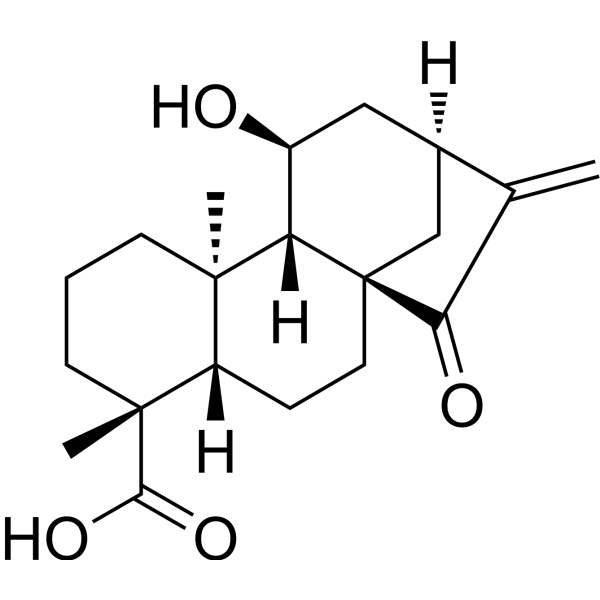
-
- HY-126052
-
|
|
COX
Tyrosinase
HDAC
|
Metabolic Disease
Cancer
|
|
Gnetol is a phenolic compound isolated from the root of Gnetum montanum . Gnetol potently inhibits COX-1 (IC50 of 0.78 μM) and HDAC. Gnetol is a potent tyrosinase inhibitor with an IC50 of 4.5 μM for murine tyrosinase and suppresses melanin biosynthesis. Gnetol has antioxidant, antiproliferative, anticancer and hepatoprotective activity. Gnetol also possesses concentration-dependent α-Amylase, α-glucosidase, and adipogenesis activities .
|
-
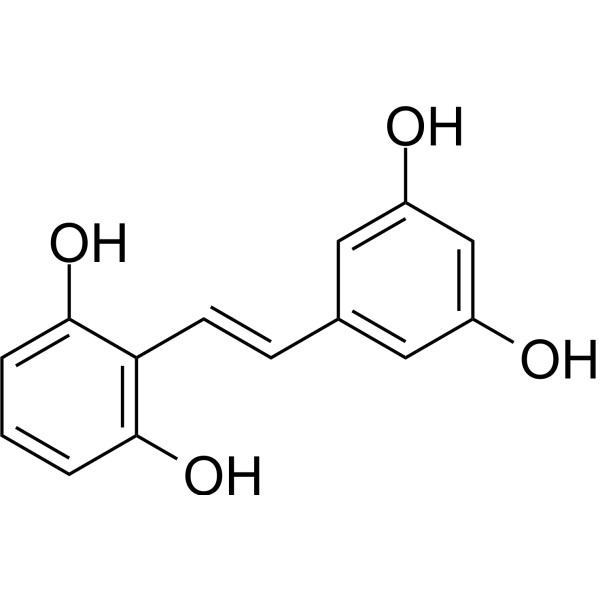
-
- HY-113068S
-
|
|
Isotope-Labeled Compounds
Tyrosinase
|
Metabolic Disease
|
|
β-Tocopherol-d3 is the deuterium labeled β-Tocopherol. β-Tocopherol is an analogue of vitamin E, exhibits antioxidant properties. β-Tocopherol can inhibit tyrosinase activity and melanin synthesis. β-Tocopherol can also prevent the inhibition of cell growth and of PKC activity caused by d-alpha-tocopherol[1][2][3].
|
-
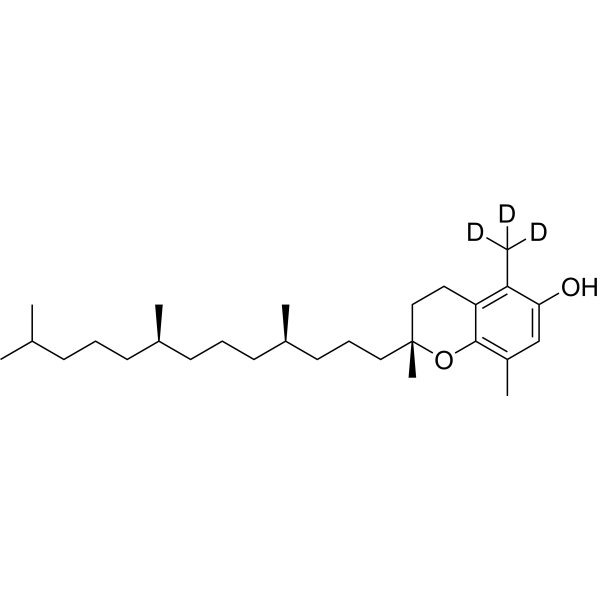
-
- HY-107663A
-
|
Pro-Leu-Gly-NH2 TFA; Melanostatin TFA
|
Dopamine Receptor
|
Neurological Disease
|
|
MIF-1 TFA (Melanostatin), an endogenous brain peptide, is a potent dopamine receptor allosteric modulator. MIF-1 TFA inhibits melanin formation. MIF-1 TFA blocks the effects of opioid receptor activation to modulate the analgesic effects. MIF-1 TFA accesses from the blood to the CNS by directly crossing the blood-brain barrier (BBB) .
|
-
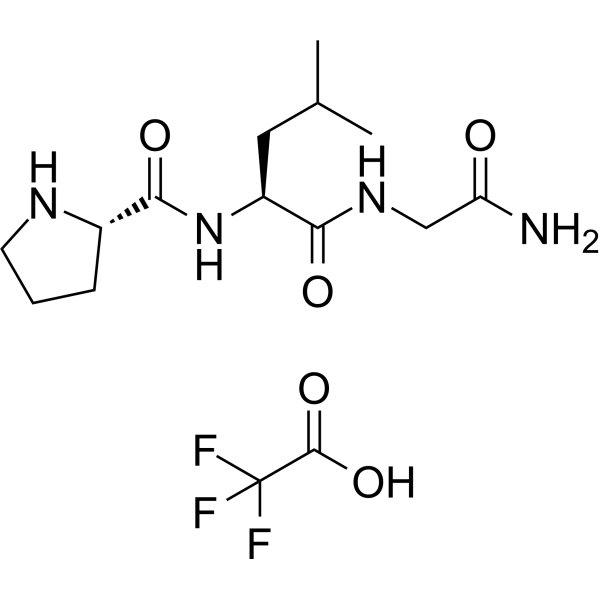
-
- HY-N1434
-
|
Methyl 4-hydroxycinnamate
|
Fungal
|
Infection
Cancer
|
|
Methyl p-coumarate (Methyl 4-hydroxycinnamate), an orally active esterified derivative of p-Coumaric acid (pCA), can be isolated from the flower of Trixis michuacana var longifolia. Methyl p-coumarate could inhibit the melanin formation in B16 mouse melanoma cells. Methyl p-coumarate also has strong in vitro inhibitory effect on A. alternata and other pathogens .
|
-
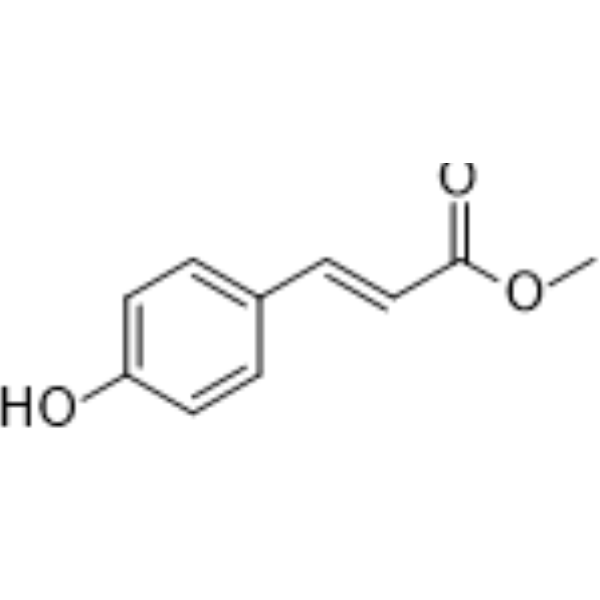
-
- HY-P0097A
-
|
Melanostatine-5 acetate salt
|
Melanocortin Receptor
|
Metabolic Disease
Endocrinology
Cancer
|
|
Nonapeptide-1 (Melanostatine-5) acetate salt, a peptide hormone, is a selective antagonist of MC1R (Ki: 40 nM). Nonapeptide-1 acetate salt is a competitive α-MSH antagonist that potently inhibits intracellular cAMP and melanosome dispersion induced by α-MSH in melanocytes (IC50: 2.5 nM and 11 nM, respectively). Nonapeptide-1 acetate salt inhibits melanin synthesis, and can be used in the research of skin pigmentation and regulation of steroid production in the adrenal gland, skin cancer .
|
-
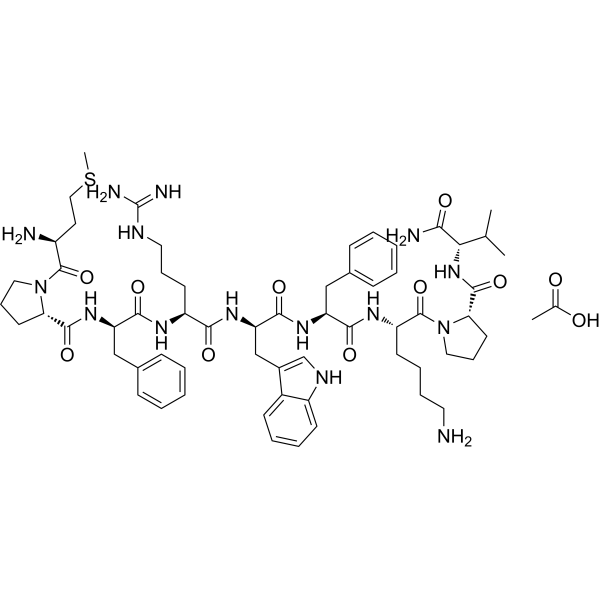
-
- HY-P0097
-
|
Melanostatine-5
|
Melanocortin Receptor
|
Metabolic Disease
Endocrinology
Cancer
|
|
Nonapeptide-1 (Melanostatine-5), a peptide hormone, is a selective antagonist of MC1R (Ki: 40 nM). Nonapeptide-1 is a competitive α-MSH antagonist that potently inhibits intracellular cAMP and melanosome dispersion induced by α-MSH in melanocytes (IC50: 2.5 nM and 11 nM, respectively). Nonapeptide-1 inhibits melanin synthesis, and can be used in the research of skin pigmentation and regulation of steroid production in the adrenal gland, skin cancer .
|
-
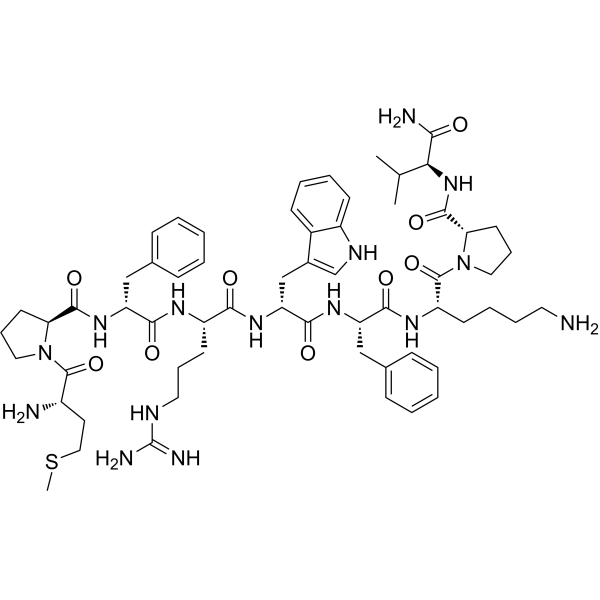
-
- HY-N10802
-
|
|
ERK
Akt
PI3K
Epigenetic Reader Domain
|
Cancer
|
|
6-O-Isobutyrylbritannilactone is a natural melanogenesis inhibitor. 6-O-Isobutyrylbritannilactone, a sesquiterpene, can be isolated from the flowers of Inula britannica. 6-O-Isobutyrylbritannilactone inhibits IBMX (HY-12318)-induced melanin production in B16F10 cells. 6-O-Isobutyrylbritannilactone also regulates ERK, PI3K/AKT, and CREB, shows antimelanogenic activity in zebrafish embryos models .
|
-
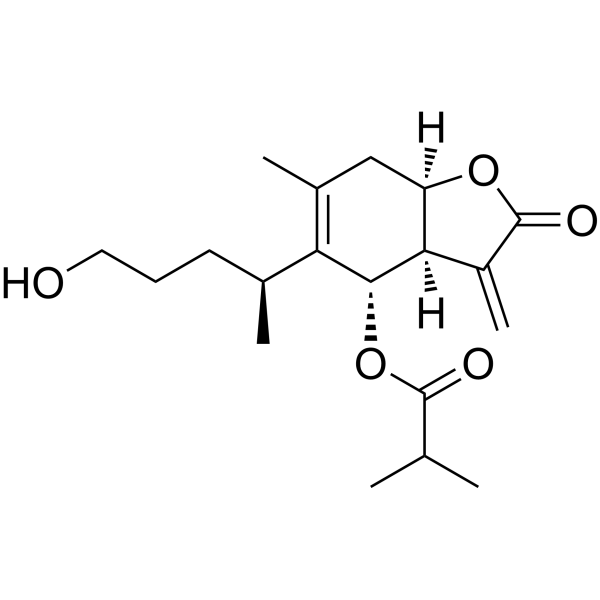
-
- HY-N3773
-
|
|
Tyrosinase
|
Cancer
|
|
Dodoviscin A is a pigmentation-altering agent, which can be isolated from the aerial parts of Dodonaea viscosa. Dodoviscin A inhibits melanin production in B16-F10 melanoma cells. Dodoviscin A suppresses mushroom tyrosinase activity, and tyrosinase activity induced by 3-isobutyl-1-methylxanthine. Dodoviscin A also inhibits the phorphosylation of cAMP response element binding protein, induced by 3-isobutyl-1-methylxanthine and forskolin .
|
-

-
- HY-W011428
-
|
|
CDK
|
Others
|
|
Olomoucine is an ATP competitive inhibitor of CDKs. Olomoucine is a purine (HY-34431) derivative and inhibits CDC2/cyclin B, Cdk2/cyclin A, Cdk2/cyclin E (both IC50=7 µM), CDK/p35 kinase (IC50=3 µM) and ERK1/p44 MAP kinase (IC50=25 µM) . Olomoucine regulates cell cycle and shows anti-melanin tumor activity .
|
-
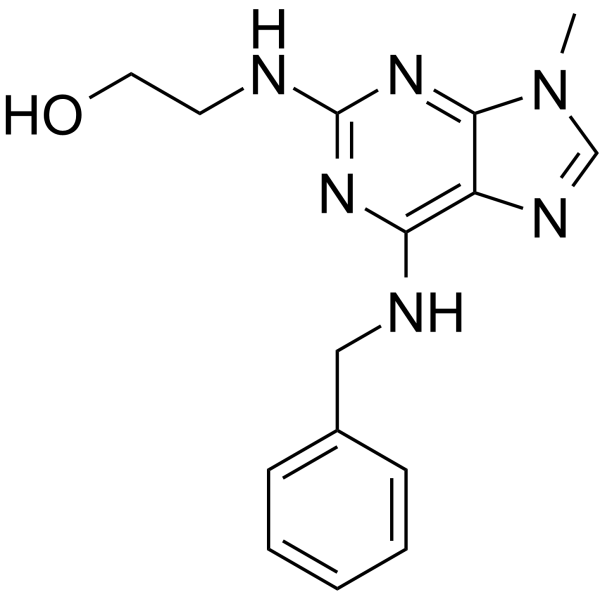
| Cat. No. |
Product Name |
Type |
-
- HY-125809
-
|
|
Biochemical Assay Reagents
|
|
4-(1-Phenylethyl)resorcinol is a skin lightening agent used in cosmetics. It works by inhibiting the production of melanin, the pigment that gives skin its color. This helps reduce the appearance of dark spots, hyperpigmentation and uneven skin tone. 4-(1-Phenylethyl)resorcinol is considered safe for cosmetic use and is approved for use in several countries.
|
| Cat. No. |
Product Name |
Target |
Research Area |
-
- HY-107663A
-
|
Pro-Leu-Gly-NH2 TFA; Melanostatin TFA
|
Dopamine Receptor
|
Neurological Disease
|
|
MIF-1 TFA (Melanostatin), an endogenous brain peptide, is a potent dopamine receptor allosteric modulator. MIF-1 TFA inhibits melanin formation. MIF-1 TFA blocks the effects of opioid receptor activation to modulate the analgesic effects. MIF-1 TFA accesses from the blood to the CNS by directly crossing the blood-brain barrier (BBB) .
|
-
- HY-P0097A
-
|
Melanostatine-5 acetate salt
|
Melanocortin Receptor
|
Metabolic Disease
Endocrinology
Cancer
|
|
Nonapeptide-1 (Melanostatine-5) acetate salt, a peptide hormone, is a selective antagonist of MC1R (Ki: 40 nM). Nonapeptide-1 acetate salt is a competitive α-MSH antagonist that potently inhibits intracellular cAMP and melanosome dispersion induced by α-MSH in melanocytes (IC50: 2.5 nM and 11 nM, respectively). Nonapeptide-1 acetate salt inhibits melanin synthesis, and can be used in the research of skin pigmentation and regulation of steroid production in the adrenal gland, skin cancer .
|
-
- HY-107663
-
|
Pro-Leu-Gly-NH2; Melanostatin
|
Dopamine Receptor
|
Neurological Disease
|
|
MIF-1 (Melanostatin), an endogenous brain peptide, is a potent dopamine receptor allosteric modulator. MIF-1 inhibits melanin formation. MIF-1 blocks the effects of opioid receptor activation to modulate the analgesic effects. MIF-1 accesses from the blood to the CNS by directly crossing the blood-brain barrier (BBB) .
|
-
- HY-P0096
-
|
|
Tyrosinase
Sirtuin
|
Inflammation/Immunology
Endocrinology
|
|
Decapeptide-12, a small oligopeptide, is a tyrosinase inhibitor that interacts with C-terminal residue of tyrosinase (Kd: 61.1 μM). Decapeptide-12 is a competitive inhibitor of mushroom tyrosinase (IC50: 40 µM). Decapeptide-12 also increases transcription of SIRT. Decapeptide-12 reduces melanin content in melanocytes. Decapeptide-12 is used for the research of melanogenesis, senescence, inflammation .
|
-
- HY-P0097
-
|
Melanostatine-5
|
Melanocortin Receptor
|
Metabolic Disease
Endocrinology
Cancer
|
|
Nonapeptide-1 (Melanostatine-5), a peptide hormone, is a selective antagonist of MC1R (Ki: 40 nM). Nonapeptide-1 is a competitive α-MSH antagonist that potently inhibits intracellular cAMP and melanosome dispersion induced by α-MSH in melanocytes (IC50: 2.5 nM and 11 nM, respectively). Nonapeptide-1 inhibits melanin synthesis, and can be used in the research of skin pigmentation and regulation of steroid production in the adrenal gland, skin cancer .
|
| Cat. No. |
Product Name |
Category |
Target |
Chemical Structure |
| Cat. No. |
Product Name |
Chemical Structure |
-
- HY-W015967S
-
|
|
|
Glycolic acid-d2 is the deuterium labeled Glycolic acid. Glycolic acid is an inhibitor of tyrosinase, suppressing melanin formation and lead to a lightening of skin colour.
|
-

-
- HY-Y0444S1
-
|
|
|
D-Tyrosine-d4 is the deuterium labeled D-Tyrosine. D-Tyrosine is the D-isomer of tyrosine. D-Tyrosine negatively regulates melanin synthesis by inhibiting tyrosinase activity. D-Tyrosine inhibits biofilm formation and trigger the self-dispersal of biofilms without suppressing bacterial growth[1][2].
|
-

-
- HY-W725641
-
|
|
|
Tricyclazole-d3 is the deuterium labeled Tricyclazole. Tricyclazole is a pentaketide-derived melanin biosynthesis inhibitor.
|
-

-
- HY-W778203
-
|
|
|
Glycolic acid- 13C2 is the 13C-labeled Glycolic acid (HY-W015967). Glycolic acid- 13C2 is an inhibitor of tyrosinase, suppressing melanin formation and lead to a lightening of skin colour.
|
-

-
- HY-Y0444S
-
|
|
|
D-Tyrosine-d2 is the deuterium labeled D-Tyrosine. D-Tyrosine is the D-isomer of tyrosine. D-Tyrosine negatively regulates melanin synthesis by inhibiting tyrosinase activity. D-Tyrosine inhibits biofilm formation and trigger the self-dispersal of biofilms without suppressing bacterial growth[1][2].
|
-

-
- HY-Y0444S2
-
|
|
|
D-Tyrosine-d7 is the deuterium labeled D-Tyrosine. D-Tyrosine is the D-isomer of tyrosine. D-Tyrosine negatively regulates melanin synthesis by inhibiting tyrosinase activity. D-Tyrosine inhibits biofilm formation and trigger the self-dispersal of biofilms without suppressing bacterial growth[1][2].
|
-

-
- HY-113068S
-
|
|
|
β-Tocopherol-d3 is the deuterium labeled β-Tocopherol. β-Tocopherol is an analogue of vitamin E, exhibits antioxidant properties. β-Tocopherol can inhibit tyrosinase activity and melanin synthesis. β-Tocopherol can also prevent the inhibition of cell growth and of PKC activity caused by d-alpha-tocopherol[1][2][3].
|
-

Your information is safe with us. * Required Fields.
Inquiry Information
- Product Name:
- Cat. No.:
- Quantity:
- MCE Japan Authorized Agent:








![3-O-β-D-Glucopyranosyl(1→2)-[a-Lrhamnopyranosyl(1→3)]-β-D-glucopyranosyl 28-O-β-D-glucuronopyranoside](http://file.medchemexpress.com/product_pic/hy-n9521.gif)














































